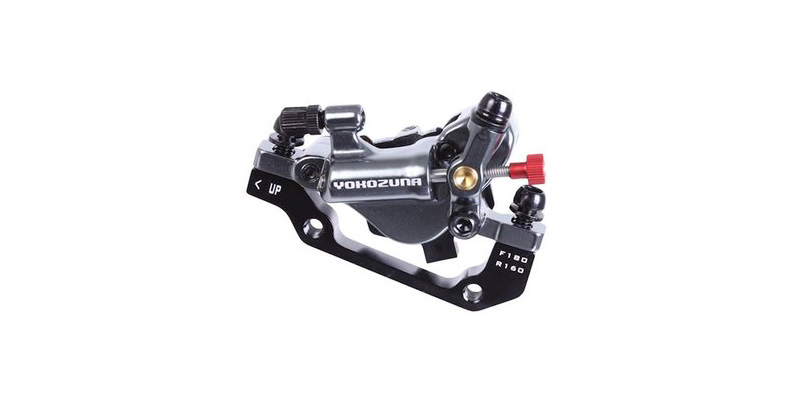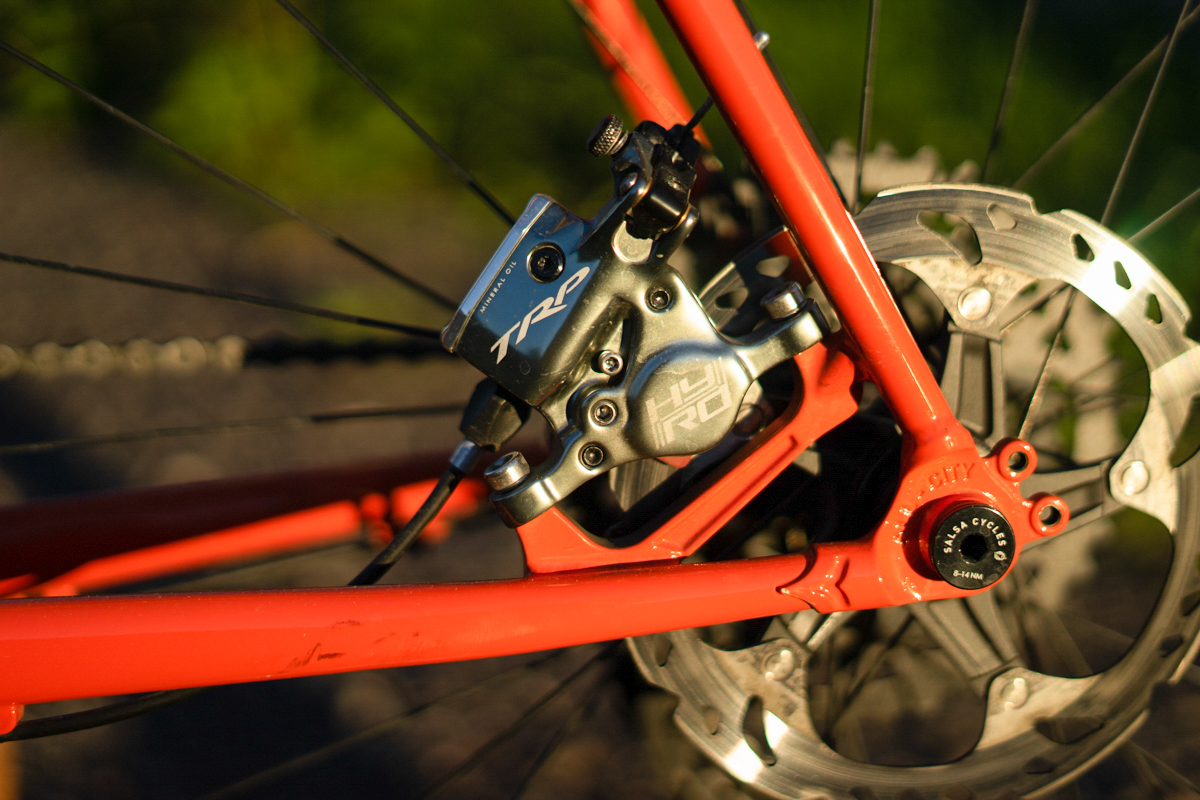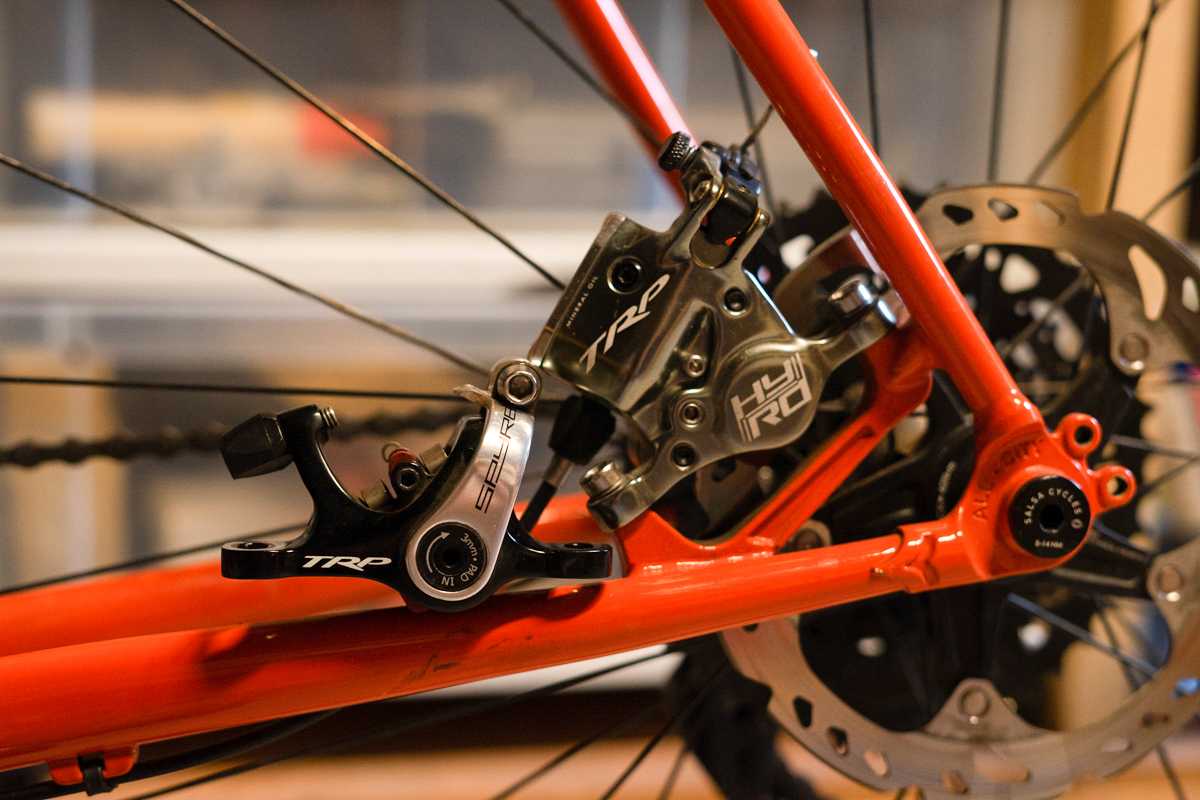Brake Check
The ecosystem of touring and bikepacking disc brakes has never been as diverse as it is today — you want to run hydraulics capable of pulling a long-travel mountain bike to a stop? Go nuts. Prefer drama-free cable actuated calipers that cost less than dinner out? You’ve got options. One need look no further than the complete bikes on sale today, which product managers spec with everything from name-brand hydros to, well, some low-level units that leave a lot of be desired.
My daily driver has, for many years, been shod with TRP’s excellent Spyre mechanical disc brakes. Dual piston, bulletproof, and easily adjustable, Spyres continue to be the gold standard of widely available mechanical discs, eclipsing even the venerated Avid BB7 (you can read a comparison between the Spyres and the beautiful-but-spendy Paul Klampers here ).
But when TRP came out with the Hy/Rd hybrid brake back around 2013 they opened an interesting door. Here was a cable-actuated hydraulic brake that pushed caliper-mounted hydraulic fluid for … the best of both worlds? As a matter of fact, yes. The Hy/Rd’s feel is closer to that of a full-hydraulic system, ditto for power. If there was one drawback to this neither-here-nor-there brake system it was a superficial one: they’re terribly ugly. With a huge protrusion housing the fluid reservoir, the Hy/Rds are the size of two typical calipers. Still, even if TRP won’t win any beauty pageants, the performance offered by the Hy/Rds and their mechanical cousins the Spyres make it hard to look elsewhere when it comes time to choose stoppers.

Until, that is, Japanese brand Yokozuna started showing up on our shores. The two-piston Motokos (there is also a four-piston Ultimo model) promise a hybrid cable/hydraulic option in a package that’s half the size, 50g a wheel lighter, and look like something that should arrive in a small, hinged wooden box. For $150 a wheel ($15 more than a Hy/RD), the Motokos arrive with a rotor and fancy compressionless housing, which they say improves performance.
For comparative purposes, I took the trusty Spyres off my Soma Wolverine and hooked up the Motokos — with new cables but without swapping to the compressionless housing. With a single pad adjustment knob, setup took only a few moments and I was quickly off to bed in the new pads. It’s tough to compare the Motokos to the Spyres — they were WAY better — but the well-loved Spyres got a teardown after six long Montana winters of daily commuting and, well, let’s just say I was afraid to sneeze for fear the loose bearings inside would turn from rust to dust.

Luckily I also had a long-term test mule sporting Hy/Rds that I could ride back-to-back to look for differences. Both bikes had 650b x 47mm tires with minimal tread, so on anything but tarmac traction was the limiting factor, not braking power. The Yokozunas offered 90 percent of the Hy/Rds’ power (this could also be affected by the much older housing their cables were pulling through) and I was never left wanting for stopping power nor feeling like my hands working too hard. The Hy/Rds seemed to have better initial bite — again, it wasn’t a perfectly controlled environment with pad and rotor differences too, including a smaller 140mm rear rotor paired with the Motokos — while the Motokos offered slightly more modulation.
For mountain bikers, I’d liken the difference to the contrast between Shimano and SRAM hydraulic disc brakes, the former of which tend to bite hard at the start but be a little more binary in their application, and the latter providing a lot of feel through the lever stroke. I’m a Shimano guy on flat bars — when I hit the brakes I want to hit them — but perhaps due to the slick tires, I found the Yokozunas preferable on dirt and gravel.

While I know that full-blown hydraulic brakes are still verboten in the touring world at large — what happens if a line comes loose while I’m in outer Mongolia?!?! — I’d still pay the premium for hydro brifters and calipers from Shimano or SRAM for almost any build and would look for that spec on all but the most dedicated touring bike offered as a complete. That said, my own drop-bar bikes tend toward the mechanical in part because, well, mechanical brifters are a lot cheaper.
So with that commitment to pulling cable at the levers, is a hybrid brakeset worthwhile upgrade for the bike traveler? If you’ve ever complained of claw-hand on long descents, ever ride your touring rig unloaded on more spirited adventures, or are just looking for a little more power, the answer is an enthusiastic “yes.” The TRP’s are proven, feel fantastic, and can be had for a few bucks less. But I also like looking at bikes, and the Yokozuna Motokos look and feel like pieces of jewelry. I think either are well worth the upgrade dollars.

